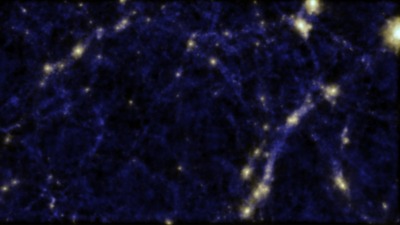Strings of galaxies found in empty space
Australian astronomers have discovered short, delicate strings of faint galaxies in what were previously thought to be extremely empty parts of space.
The scientists are based at the University of Western Australia (UWA) node of the International Centre for Radio Astronomy Research (ICRAR). Their research has been published in the Monthly Notices of the Royal Astronomical Society.
The universe is full of vast collections of galaxies that are arranged into an intricate web of clusters and nodes connected by long strings. This structure is often called the ‘cosmic web’, with busy intersections of galaxies surrounding vast spaces, empty of anything visible to us on Earth.
“The spaces in the cosmic web are thought to be staggeringly empty,” said Dr Mehmet Alpaslan, who led the research. “They might contain just one or two galaxies, as opposed to the hundreds that are found in big clusters.”

For years, astronomers have been trying to understand the small population of galaxies that inhabit these spaces, known as voids. Using data from the Galaxy and Mass Assembly (GAMA) survey - an international collaboration to map the universe - Dr Alpaslan and his colleagues found that these galaxies are arranged in a way never seen before.
“We found small strings composed of just a few galaxies … a completely new type of structure that we’ve called ‘tendrils’,” said Dr Alpaslan.
The researchers described the tendrils as “coherent, thin chains of galaxies that are rooted in filaments and terminate in neighbouring filaments or voids”. Using the line correlation function, they proved these tendrils “represent real structures rather than accidental alignments”.
The GAMA team created the largest ever galaxy census of the southern skies using observations from the Anglo-Australian Telescope in NSW. Dr Aaron Robotham, from the UWA node of ICRAR, said, “Our new catalogue has looked deeper into space and mapped each patch of sky up to 10 times to make sure it’s as thorough as possible.
“We weren’t sure what we’d find when we looked at voids in detail, but it was amazing to find so many of these tendrils lurking in regions that have previously been classified as empty.”
Dr Alpaslan explained, “This means that voids might be much smaller than we previously thought, and that galaxies that were previously thought to be in a void might just be part of a tendril.”
Colon cancer DNA in blood can guide chemo decisions
A simple blood test could change how doctors decide which patients with colon cancer need...
Non-invasive blood test helps rule out oesophageal cancer
Designed and developed in Australia, the PromarkerEso test is designed to offer a quick,...
Taste-based flu test enables rapid diagnosis
The diagnostic tool consists of the sensor molecule thymol and a virus-specific sugar building...





